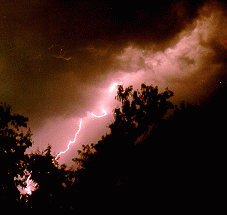
This picture was taken using the circuit.

Description
This circuit is used to trigger a camera’s electronic shutter circuit when a flash of lightning is present. It has been suggested that this circuit would also work to photograph fireworks displays. The photodarlington should be set up to either look through the camera’s viewfinder or a small black tube that gives the same view as the camera’s lens. With an SLR camera, this circuit should only be used at night, daytime use will cause it to retrigger indefinitely because the viewfinder goes black then light when the photo is done, this restarts the detector. When using the circuit, be sure to stay away from sources of flickering light such as street lights and fluorescent lights, they will cause false triggering. It is normal for the circuit to activate constantly when in the presence of indoor lighting. I recommend testing the circuit by shining a flash light across the detector in a completely dark room. The original photodarlington transistor I used was a QT semiconductor model QT-L14R1. A similar part that is available from Digi-key is the Optek OP560C, part number 365-1073-ND. The VN10KM is an N channel mosfet transistor, a more common IRF520 would probably work here, but I have not tried it. The 4047 is a standard 4000 series CMOS one-shot, Digi-key sells it as part number CD4047BCN-ND. If you get any good photos using this circuit, I would love to see them.
Theory
In a nutshell, the photo darlington converts light pulses into electrical pulses, the first LM324 section amplifies the electrical pulses, the second LM324 section is a high pass filter that only passes quick changes (lightning). The third LM324 stage is a comparator that allows only large pulses to pass through, and the 4047 one-shot stretches out the length of the pulses so that they are long enough to drive the relay and trigger the camera. The 2N3904 drives the reed relay, and the VN10KM prevents the circuit from triggering when it is first turned on. The LM324 GND Ref circuit provides a reference voltage at 1/2 of the 9V battery for use in the other op-amp circuits.
Lightning Detector in PostScript format
External Links
- Lightning web ring for lots of lightning stuff.
- Here are more lightning pictures taken by someone who used a modified version of this circuit.
- Matthew Cole has put together a web page full of interesting lightning photograpy pictures and resources.
- Here’s where you don’t want to be when lightning strikes.
- Some useful information about lightning and grounding.
- NASA’s GHCC Lightning & Atmospheric Electricity Research site.
Sources
- Forrest Cook http://www.solorb.com/elect/